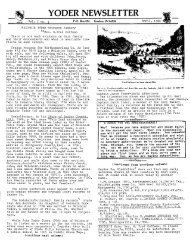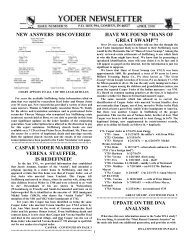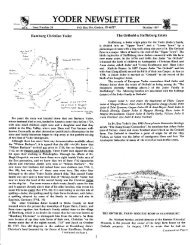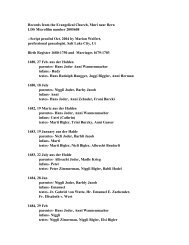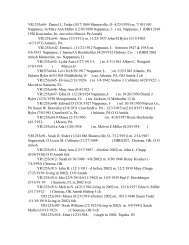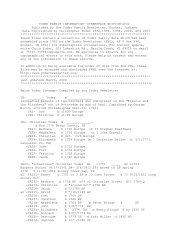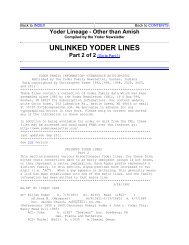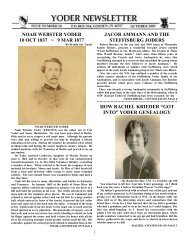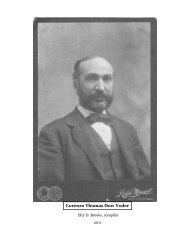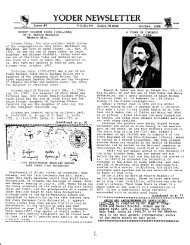w YODER NEWSLETTER - Yoder Family Information
w YODER NEWSLETTER - Yoder Family Information
w YODER NEWSLETTER - Yoder Family Information
Create successful ePaper yourself
Turn your PDF publications into a flip-book with our unique Google optimized e-Paper software.
St. Joder Chapel (from Page l)<br />
an area in the Niwald region. It turned out to be<br />
a tiny white chapel in a picturesque valley' 1000<br />
meters above sea 1evel, located halfway between<br />
Stans and Engelberg, with Grafenort, on the highway<br />
be1ow, the nearest vi11age. It stood alone<br />
except for the farmhouse nearby, and the people in<br />
the surrounding community could te11 her very<br />
Iittle about it. Her best information came from<br />
Dr. Ephrem 0m1in from the monastery in Engelberg.<br />
In 1978 when we too visited the chapel, we<br />
founcl in a window-well of the little building an<br />
eight-page brochure, protected with plastic'.<br />
entitled: Die Kapelle St. Joder muss restaurigrt<br />
werden, Dated September 19?0. It was a suppleiEiTTo<br />
the Nidwainer volksblatt and it was<br />
apparently a-!'uffiTion E generate enthusiasm<br />
for one more attempt to restore the chapel, a<br />
project that seems to have been spear-headed by<br />
Karl Jocler of Germany. A whole series of effofts<br />
had preceded this one. In 1501 an earthquake<br />
twisted the tower and made new foundations necessarv.<br />
Further repairs were made in I72?, in 1799'<br />
ana tg??, tn 1963 a heavy southwest wind again<br />
blew down the tower. Now in this latest appeal'<br />
because the loca1 population could not finance<br />
the refurbishing, it was hoped that a wider circle<br />
of friends and patrons could raj-se enough<br />
money so that work could begin by 1972,<br />
Fron this brochure we pass on to you some bits<br />
of information you might like to know before you<br />
go up the mountain to this romantic spot. This<br />
community of Altzellen takes in about fifty. larmsteads,<br />
with a population of approximately 4JO,<br />
who are sti1l devoutly Roman Catholic although<br />
they have not been organized into a particular<br />
parish. The earliest document extant about the<br />
iegion comes from 126?. Even by then it had been<br />
settled for a long time. However, in reading<br />
through the names of the earliest inhabitants<br />
known to have cleared the forest and nade the<br />
fields, we cannot find the name of Joder or any<br />
name we know associated with it (with the conceivable<br />
excepti-on of Baumgartner). Before this<br />
date there were Joders across the nountains in<br />
the Canton of Bern, but so far we have found no<br />
evidence that A1tze11en was ever considered a<br />
Joder "heimat". One of Karl Joder's maps shows<br />
a Joder farnstead that might have been within<br />
twenty miles.<br />
An anonymous wri-ter at the end of the brochure<br />
makes an iirteresting and plausible speculationfnere<br />
is general agieement that that the chapel<br />
was built"in 1482, and he notes that on December<br />
ii, t4gt, a special meeting of the Diet was held<br />
in Stans. not far awav:<br />
"After the Confederates had thoughly<br />
conquered Duke Karl the Brave, they<br />
returned as great victors to their<br />
homes, but after the victory over<br />
the enemy they began to quarrel about<br />
the di.vision of the booty and the<br />
claim of the tribes that had ioined<br />
in the fight (Freiburg and Solothurn).<br />
The more impossible a peaceful soluti-on<br />
seemed, the more both sides put<br />
this tangled ball before Brother Klaus..."<br />
(a monk "on the border" of the area). There were<br />
those who believe that by the time of the Diet<br />
meeting, drafts of a contract had already been<br />
made up, but because of their common trust in<br />
Brother K1aus, he was able to bring about the<br />
signing of the document to the satisfaction of<br />
all concerned--no rnean feat. ,'Bel_ls were runs<br />
everlrwhere " .<br />
A<br />
+.<br />
'Ihe<br />
mayor and the aldermen from<br />
Solothurn wrote to him: 'We have<br />
been informed that you through the<br />
grace of the Alnighty God and His<br />
dear Mother have created peace,<br />
quiet, and union in the whole confederacy<br />
through your good advice<br />
and instruction.<br />
t "<br />
The writer continues:<br />
"Wouldn't you expect<br />
that somewhere the Confererates would have put<br />
up a nemorial to remember this day...to the<br />
peace that had come out of gratitude that they<br />
had been saved from a civil war...?" Elsewhere<br />
he refemeil to a tradition that every<br />
evening a strip of light would appear on this<br />
height<br />
"under<br />
the Eggiligrat", which was the<br />
deciding factor in locating the chapel at that<br />
p1ace. Thus in November of 1482 the new chapel<br />
was dedicated by the Bishop of Constanz to "St.<br />
Joder and the God Mother", and a decision was<br />
made by the mountain population to hold a<br />
memorial annual1y.<br />
Brother Klaus was among the most noted<br />
benefactors. A nass robe he gave is stiIl<br />
of the<br />
preserved<br />
in the church in nearby Wolfenschiessen.<br />
Various relatives of farnilies in A1zellen contributed,<br />
foremost among them the Fliie family<br />
of Saxony, with whom the mother of Brother Klaus<br />
seems to have had connections. Their patron<br />
saint back in Saxony was St. Theodulus (St. Joder),<br />
a logical choice therefore for the patron of the<br />
new chapel. fn conclusion there is a quotation<br />
from the treatise on Brother Klaus by Robert<br />
Durrer:<br />
"In Nidwalden and beyond, worship of the<br />
saint had been unknown so that the influence of the<br />
Saxons in the face of such genealogical relations<br />
nust be almost certain. "<br />
tfe thus have better exnlanations about the<br />
origin of the chapel that- the speculations and funguesses<br />
made by our earlier American visitors.<br />
The chapel did not come about because of any sacriflcial<br />
grass-roots effort of a 1oca1 clan (1ike<br />
Jodersl). Probably from the beginning the symbolism<br />
may have meant more to the upper echelons of<br />
power than to the farmers around it. Support<br />
for it probably came from some places rather far<br />
away and in spasmodic fashion. It did not fa11<br />
into periodi-c neglect because some clan (1ike<br />
Joders) had turned Protestant and moved awayr the<br />
chap_el has always been in Catholic care. Although<br />
local people may not have been able to explain<br />
much about the chapel.twenty years ago, tirey were<br />
willing.to put up a sign pri,mltfv to te11 the<br />
rasclnated American visi_tors where to find it.<br />
None of the facts or fancies or errors need to<br />
dull our i-nterest in or appreciation of this romatic<br />
little chapel in such a beautiful setting, a setting<br />
which must be much like that which our Siiss forefathers<br />
knew and 1oved. It is sti11 a house of<br />
prayer and the bell can be a call to prayer as far<br />
as the sound can reach. Historians can itilt<br />
appreciate its antiquity; artists can sti11 stuclv<br />
the style and origins of the altar pieces. Speciil<br />
services are held there several times a year, ancl<br />
Benedictines from Engelberg, spending va6ations at<br />
"bring<br />
Grafenort,<br />
the holy sacrifice-up here."<br />
Some.young couples are choosing the ch-pel for their<br />
weddings and the bell still tolls for a- death in the<br />
va11ey. Whether our ancestors had anything to do<br />
wi.th it or not, a visit to the St. Jorter 'vqv* Chanp] v'r$Hv+<br />
can be an enjoyable experience.<br />
(In a later issue we shall describe the interior<br />
of the chapel and show what interesting myths<br />
and legends about St. Joder are illustrated in<br />
the 17th century paintings on the wa1I. )



